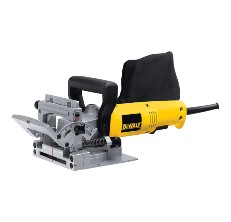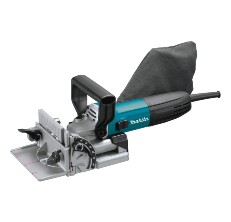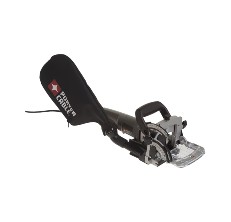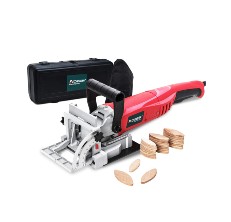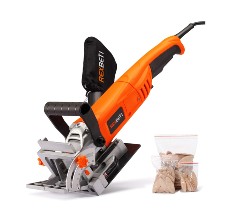The Best Plate Joiners to Enhance Your Woodworking Projects
- DEWALT Plate Joiner Kit - Best Overall
- Makita PJ7000 Plate Joiner Kit - Runner Up
- PORTER-CABLE Plate Joiner Kit - Honorable Mention
- AOBEN 8.5 Amp Biscuit Cutter Plate Joiner - Contender
- REXBETI Wood Biscuit Plate Joiner Kit
If you are into professional woodworking and carpentry, you would know the importance of having a reliable power tool to make your work easier. While you usually work with power saws, drill machines, sanders, and other power tools, you can also make use of a plate joiner when it comes to joining different pieces of wood together.
A plate joiner is a handy power tool that is fitted with a circular saw and helps you cut a circular hole into the surface of the wood pieces, which can then be joined together with the help of a wooden disc, which is also called a biscuit and slides into the holes of both wood pieces when they are placed together. This is why plate joiners are also called biscuit joiners.
If you think you need a plate joiner in your workshop but don’t know how to choose one, we are here to help. We have rounded up some of the best plate joiners of 2024, for which we evaluated hundreds of options and shortlisted the best ones. We have also included a buying guide at the end to help you understand the factors involved in choosing a plate joiner.
Comparing the Best Plate Joiner of 2024
DEWALT Plate Joiner Kit
– Best OverallThe DEWALT Plate Joiner Kit is one of the most reliable and powerful plane joiners that you can find out there. It is equipped with a 6.5 amp heavy-duty motor that achieves a speed of 10000 RPM, thus allowing you to cut through harder materials with ease and precision. The joiner also consists of a dual rack and pinion fence to keep the blade parallel to the fence and ensure accurate cuts. The angle of the one-piece fence can be easily adjusted between 0° and 90°.
This plate joiner also comes with a non-marring heavy-duty aluminum shoe that enables you to clamp down the machine to a work table or bench when needed.
- Contains set depth stops for common biscuit sizes
- Comes with retractable and anti-slip pin to hold workpiece
- The handle is attached to the motor, which causes more vibration
Makita PJ7000 Plate Joiner Kit
– Runner UpThe Makita PJ7000 Plate Joiner is a heavy-duty and handy power tool that allows you to work with different types of wood easily. It is powered by a 5.6 amp motor that provides a speed of 11000 RPM and allows for smooth and precise cutting. It features a pivot fence that is made from cast aluminum and features three stops: 0°, 45°, and 90°. Plus, the plate joiner also contains a solid rack and pinion fence that powers up the joiner to 11000 RPM and ensures a smooth performance.
This plate joiner has a user-friendly and well-sized cam that you can lock when adjusting the angle of the fence. It also has six different values for depth that you can choose between, ranging from #0 to #20.
- Has a compact and user-friendly design
- Preset depth adjustment for easy changing
- Need some practice before mastering its usage
PORTER-CABLE Plate Joiner Kit
– Honorable MentionThe PORTER-CABLE Plate Joiner Kit is a reliable machine with a powerful 7-amp motor that spins the blade at a speed of 10000 RPM. It also has a lock-on trigger that helps you control the speed and also stop it at a certain value when needed. It comes with the joiner fence attached, which you can tilt between 0° to 135° with a predefined stop at 90°. The plate joiner is equipped with a 4” diameter blade that allows for quick and precise biscuit cuts.
You can make use of the micro height adjustment knob to choose the correct height you want to make a cut at. This plate joiner also has seven preset values for the depth, which include FF, #0, #10, #20, simplex, duplex, and max biscuits.
- Comes with dust port and dust collection bag
- Spindle lock allows for changing wrench bit easily
- Takes some time to be set up and adjusted
AOBEN 8.5 Amp Biscuit Cutter Plate Joiner
– ContenderThe AOBEN Biscuit Cutter Plate Joiner is a handy multipurpose machine that allows you to cut through wood pieces for making different types of joints, including corner joints, miter joints, frame joints, centre wall joints, and butt joints. It is suitable for use with wood, chipboard, plywood, fiberboard, plexiglass and even artificial marble that has a thickness greater than 8mm. The machine has an 8.5-amp motor with a cutting speed of 11000 RPM, and its 4” diameter blade ensures clean and precise cuts with a groove width of 4mm.
This plate joiner features fixed settings for common biscuit sizes, such as #0, #10, and #20. Plus, you can also make use of the manual mode to set a custom depth.
- Features adjustable tilt fence between 0° and 90°
- Comes with dust bag for easy dust collection
- The adjustable fence is a little wobbly
The REXBETI Wood Biscuit Plate Joiner Kit has a compact and lightweight construction, and is equipped with a 8.5-amp motor that runs at 10000 RPM and makes it suitable for working with harder wood pieces. It also comes with an adjustable tilt fence that can be set at any angle between 0° and 90° for quick and precise cuts. You can also adjust the fence angle with the included angle knob. There are preset depth settings to choose from, such as #0, #10, #20, and manual mode to help you set a custom depth.
This plate joiner also comes with 100 biscuits with depth levels ranging from #0 to #20. They are each packed separately to allow for quick retrieval.
- Allows you to set custom cutting depth
- Has an ergonomically designed handle for better grip
- Dust clogs the motor despite the extraction feature
Best Plate Joiners Buying Guide
What is a Plate Joiner?
A plate joiner, or biscuit joiner, is a power tool used by woodworkers to cut slits or circular holes in different types of wood, and its primary purpose is to provide a stronger and more secure bond between two workpieces that have to be joined together, and wood ‘biscuits’ are slid into the holes created by the joiner for this purpose.
Plate joiners are particularly useful power tools for carpenters and woodworkers, as well as DIY enthusiasts who like to join different pieces of wood together to create furniture or other accessories. The machine makes the holes using a circular saw mechanism, and has a sharp round blade fitted inside it, which is pushed forward by the motor into the material.
Plate joiners also contain a rack and pinion fence, which allow you to set the height at which you want to make the hole in the wood piece, as well as an angled fence that lets you adjust the angle of cutting. This makes the plate joiner suitable for making holes for all types of joints, including miter joints, corner joints, and many others.
How to Use a Plate Joiner?
A plate joiner helps you make joints between two wood pieces much stronger than they would be by just using glue. It requires a certain level of practice before you can start using it perfectly, but it isn’t impossible to learn. To start with, you can line up the pieces of wood that have to be joined together. Make sure that their grains are facing the same way, and they are placed in the same direction in which they will be joined.
Next, use a pencil to mark the places where you want to make the biscuit cuts. Once you have marked the places, the next step is to select the depth and angle of the cut on your plate joiner. Then, grabbing the handle of the plate joiner, guide it towards each piece of wood, with the line of the fence coinciding with the markings you have made. Turn the joiner on and push it towards the wood, which will cut a hole into the surface.
When the hole is cut properly, the blade will retract and spin idly, following which you can turn it off and remove it. Repeat these steps with each cut you have to make. The last step is to apply glue on the biscuits and place them inside the holes, and clamp the pieces together to allow them to stick perfectly.
Things to Consider Before Buying a Plate Joiner
There are numerous factors that you should keep in mind whenever you have to choose between various plate joiners. Here are some of the key factors that you should apply.
Power Source
Just like most power tools, plate joiners also come in corded and cordless variants. While corded options are more powerful and have a higher cutting speed, cordless plate joiners offer more convenience and portability. Plus, you can also carry them with you for various woodworking jobs, and you also don’t have to worry about snagging or tugging on the cord while working.
Make sure to choose the one that suits your style of work better, so that you don’t have to compromise anything when you are using it to make biscuit cuts.
Blade
Most plate joiners have 4” diameter blades, which are sufficient for creating a large enough hole to fit biscuits of different depths inside it. However, if you are looking to make smaller cuts, you may be able to find plate joiners that are also compatible with a 2” diameter blade and you can easily switch the blades.
Cutting Depth
Cutting depth is one of the key factors, and most models of plate joiners have preset levels to choose from, such as #0, #10, and #20. These are the most common biscuit sizes, and they allow you to quickly set the depth. Moreover, some models also allow you to set custom cutting depths, and they are suitable if you know the depth you require in your projects.
Cutting Speed
The motor of the plate joiner is responsible for its speed, and the higher the cutting speed, the smoother and more precise its performance will be. Most plate joiners have a cutting speed of 10000 or 11000 RPM, which is suitable for cutting through harder materials as well. Plus, this cutting speed is sufficient to prevent overheating, which is often caused when the blade works slowly. If you have to make smaller cuts or are working with softer materials, then you can afford to have a plate joiner with a lower cutting speed.
Handle
Although this may not seem as important, having an ergonomically designed handle makes all the difference when you are operating a plate joiner. Typically, you can find two types of handles in plate joiners: D-type and barrel type. The D-type handles have the trigger close by, which allows for better speed control, whereas the barrel type handle is installed closer to the fence, which enables you to have better control over the machine. Make sure to choose the handle that you can hold comfortably.
Plate Joiner FAQ
Ideally, you should choose a plate joiner that delivers a cutting speed of at least 9000 RPM, as this makes it suitable for cutting holes in harder materials.
Generally, you can cut as deep as ¾” with a plate joiner, and you can fit #20 biscuits into the hole perfectly.
The best way to ensure maximum strength between two pieces of wood is to leave a space of 6” to 8” between each cut. This is sufficient to allow the two pieces to stick together strongly.
The Woodsmith Review Team’s product reviews and in-depth guides are here to help you choose the best tools and gear to build great-looking projects confidently. Woodsmith is reader-supported: When you buy through links on our site, we may earn an affiliate commission. Large language models (like Artificial Intelligence) may have been used in the research and creation of the content.
Inquiries regarding specific articles or product testing should be sent to aimperiapt@gmail.com

